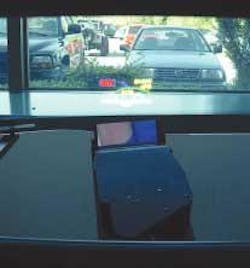At the 2004 Society for Information Display meeting (May 23–28, 2004; Seattle, WA), Microvision Inc. (Bothell, WA) unveiled a prototype of a new head-up display (HUD) for use in cars. This latest system—in its final package—could take up as little as half the volume of displays based on light emitting diodes (LEDs) and liquid-crystal displays (LCDs). It also has a dynamic range of millions to one, offers a power advantage, and can produce bright images without a cooling system. The system uses the windshield as an optical combiner without image distortion or the need for custom optics. Prototypes have been installed in BMW and Audi test vehicles, and Microvision is now working with partners to get the HUDs into car showrooms by 2007 or 2008 (see figure).
Head-up displays were first discussed as car components in the 1980s, but failed because optoelectronic technology was insufficiently advanced. In particular, light sources took up too much space and power, and required cooling. The development of high-brightness LEDs in red, green, and blue solved this problem to the extent that BMW now offers a HUD with its new 5 and 6 Series models (the image is produced using LCDs). With scarce dashboard space and thin profit margins in the automobile industry, however, systems will have to get smaller and cheaper for the LCD-based systems to make it into mainstream vehicles.
Efficient use of light
Microvision's technology, the core of which has been used for imagers and personal displays (see Laser Focus World, August 2003, p. 50), has several advantages. First, because the image is produced by just three laser diodes—each of which is scanned by a single biaxial micromechanical mirror—the device is inherently lightweight; adding pixels does not increase bulk. Second, the lasers are modulated so they produce only the light required for a specific pixel at any particular moment. Not only does this mean that the laser diodes require little power, but more important, when they are off, they are completely off. In contrast, with LCD-based systems, small amounts of light can get through completely black pixels, producing a glow on the windshield that can be noticeable—and distracting—in low-light conditions.
Other issues have been overcome to ready the technology for this new application. Most critical was the problem that windshield optical qualities vary not only for different makes of cars, but also for different models of the same make. This issue has been tackled in two ways. First, the resolution the display can provide is higher than the driver can see, meaning that a tradeoff can be made by using some of the resolution to predistort the image. The warping is produced electronically and is based on the shape of the windshield. To ensure that the image is fully calibrated for each individual car before it leaves the factory, Microvision engineers plan to develop an optical-feedback system, using an inexpensive camera to capture the windshield shape to help select the proper predistortion algorithm.
Engineers say one of their biggest challenges was to produce a highly uniform, easy-to-view, virtual color image with a simple set of optics. First, the natural view zone of a scanning display is very small; if the light is not directed into the eye, the image is invisible. This problem has been solved through careful design of the microlens array that acts in the system as an exit-pupil expander, widening the field of view of the device to around 15°.
Another problem is that focused-spot sizes for the red, green, and blue components are different, producing pixels that naturally take up different amounts of space and prevent the formation of a fully white image. Third, with a conventional Gaussian beam, pixels are brighter in the center than at the edges, producing a grid pattern on the display. Both problems have been solved by shaping the laser beam on entry to the system so that it has a tophat distribution. In conjunction with the spreading of the microlens array and following projection lens, the viewer sees the resulting pixel as an entire hexagonal lenslet, evenly illuminated. These lenslet pixels tile to produce a uniform, artifact-free image.
Because lasers are used as the light source for the HUD, speckle caused by interference of coherent beams diffracting from a rough surface had to be eliminated in the optical design. The Microvision team has shown that one of the advantages of the beamlet-based system (a beamlet being the beam that emerges from a particular microlens) inherently prevents speckle. Though interference does still occur, the pattern produced is on a scale that would normally not be visible to the driver.
About the Author
Sunny Bains
Contributing Editor
Sunny Bains is a contributing editor for Laser Focus World and a technical journalist based in London, England.
